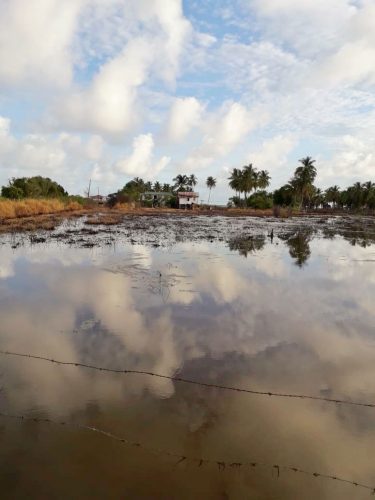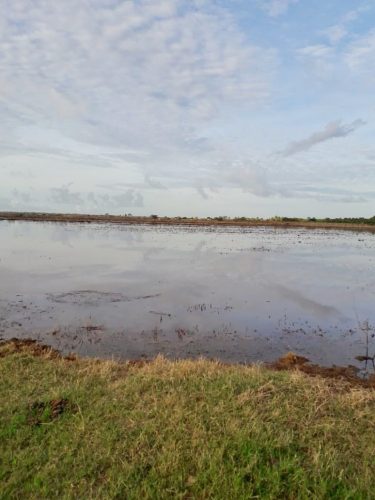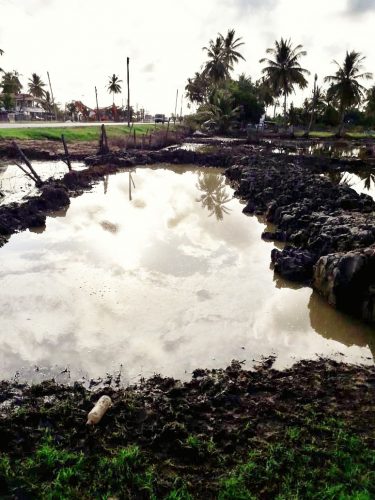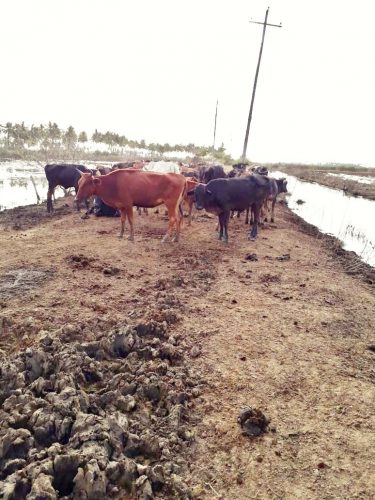Following flooding due to spring tides and sea defence breaches, parts of some Mahaicony villages remain inundated with stagnant salt water as a result of the blocking of a drainage canal by a farmer seeking to protect his own rice crops from being flooded.
Recent floods in Mahaicony have left farmers counting millions in losses.
As an intervention, a dam was constructed on the northern side of the public road from Columbia to Fairfield to prevent further flooding and damage. The constructing of the dam hasn’t altogether stopped the sea water from getting in as some days there is still overtopping.


Maniram Doodnauth, a farmer living in this section of Glazier’s Lust, told Stabroek News that he and other farmers did not realise the canal was blocked until a recent check to determine why the water wasn’t receding.

Doodnauth said that in trying to get the farmer responsible for the situation to break the dam, he and others were met with profane language.
The man said after he contacted the Civil Defence Commission, he was told that the canal was on privately-owned land and, therefore, it could do nothing about it. Doodnauth and other farmers, however, maintain that this is not true and the land in fact belongs to the government.
Doodnauth further said that the land was decades ago privately owned by various farmers but sometime shortly after the People’s Progressive Party administration took office, farmers like him in the other side of Mahaicony gave up their lands to have drainage and access to the Broken Waterland Canal. “We signed permission allowing respective authorities to dig through the land and join the Prospect and Broken Waterland Canals. Earlier this year there was a drought and people were worried about not getting water then the salt water come in and duck the land. My nephew lose one third of his crops. Another guy lost about forty acres of land. Minister (of Public Infrastructure) David Patterson visited High Dam some time ago and after he sent officials to open the canal but they didn’t open the canal. These same men said to us that if they open the canal the man rice fields will be flooded out but he has two dams on both sides of his farm to prevent the water from getting in so he won’t get flood,” Doodnauth said.

Thousands of acres of land are still under water, including land used for farming and for grazing of cattle. The salt water, Doodnauth said, has damaged the land to such a degree that it would take years for anything to grow in them again, including grass. Any green vegetation to have been covered by the flood has been damaged to such an extent that they are rust red in colour. With all the fresh water in this area being polluted by the salt water, cattle owners requested that excavator operators dig them a pond in the road to provide the animals with proper water to drink. The animals were also forced to sleep on the railway embankment night after night.
Doodnauth, who is 70-year-old, says he has never experienced such a disaster in all his years. With the water having nowhere to go, it has become stagnated and gives off a foul odour. “I’m appealing to the people in authority to get the Broken Waterland Canal open. The tide is expected to come very high again. We are fearful because the tide is expected to come higher,” he added.
Calls to the Chief of Sea and River Defence Officer Kevin Samad went unanswered.






